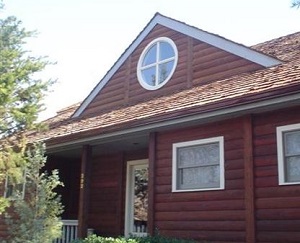Rocky Mount Roof Cleaning Contractor
 In the southeastern United States, with the warm temperatures and
high humidity, there is a growing problem with algae on roofs and
particularly asphalt/fiberglass shingled roofs.
In the southeastern United States, with the warm temperatures and
high humidity, there is a growing problem with algae on roofs and
particularly asphalt/fiberglass shingled roofs.
This algae known as Gloeocaps Magma which is identified by the
brownish black streaks seen on the shingle usually appears on the
north side of the house first. This is where there is the least sun
and the most moisture. With a warm moist surface, the only thing the
algae needs is a food source to grow and spread. The food source is
limestone.
Shingle manufactures add a crushed limestone mixture to the asphalt
fiberglass shingle mainly to add weight. With the high cost of
petroleum used in the asphalt, the manufactures needed to find a
cheaper way to make the shingle so they introduced fiberglass. This
reduced the asphalt, but also made the shingle too light. Therefore
the relatively cheap limestone was added.
Now the question becomes, is the algae a problem or just an
eyesore?
Not only an eyesore, but Gloeocapsa Magma in some extreme cases left
untreated can become a health issue to some with chronic breathing and
allergy problems. But in general, the algae will just continue to grow
until the entire roof is covered. With the roof granular covered with
algae, it inhibits the ability to reflect the UV rays of the sun. This
in turn causes excessive heat build up in the attic which not only
causes higher cooling costs, but also increases the deterioration of
the shingles.
In its early stages, Goleocapsa Magma is more of an eyesore, but as it
grows, it can become a significant problem. The best advice is to have
it removed by a professional roof cleaning
contractor when it becomes unsightly.
Taskmasters uses a No Pressure technique approved by
A.R.M.A. (American Roofing Manufactures Association) to remove the
algae safely without damaging the roof. Give us a call with any
questions, we love to help.











